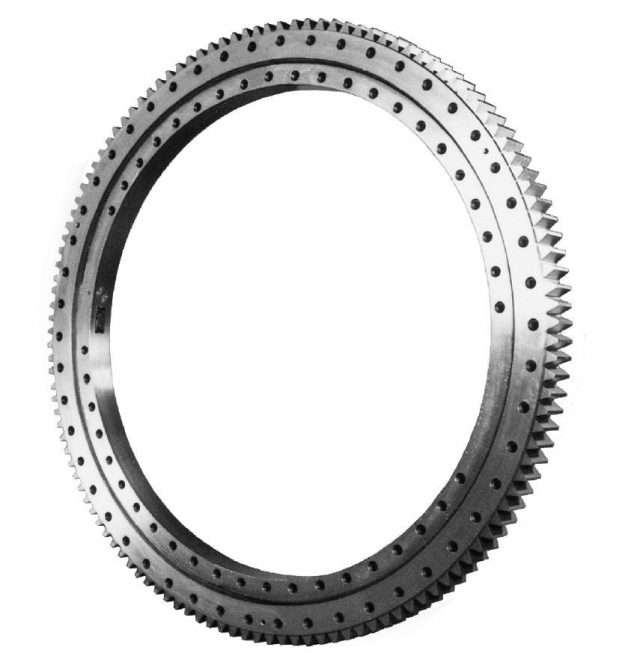best selling slewing bearing in stock
1.How does slewing bearing paint rust form? How to prevent?
Bearing paint rust often occurs in slewing bearings installed in closed equipment, generally manifested as rust inside the bearing and a strong paint smell.
Slewing Bearing paint rust is a frequent problem, which may affect the normal rotation and service life of the bearing. So how does bearing paint rust form, and how to prevent it every day?
First, the cause of the formation of bearing paint rust
Generally, the bearing with paint rust is generally on the end face near the inner side of the motor, and will be seriously rusted. The grease near the edge of the inner and outer rings will first deteriorate, generally yellowish brown.
The reason for the formation of bearing paint rust refers to the fact that during the slewing bearing paint rust test, it was found that the severity of bearing paint rust was closely related to the humidity. Most of the paint rust occurs in the south or the coast to coincide with the imagination of the annual rainy season.
1. The climate environment is high temperature and high humidity.
2. The stator drying is incomplete;
3. Motor bearings are sealed and packaged in storage;
4. The severity of paint rust mainly depends on the composition of the paint base.
5. Prevention of paint rust (bearing seal and rust prevention, type of grease).
Second, the prevention method of bearing paint rust
The prevention of bearing paint rust must be considered in terms of its mechanism, from the design and manufacture of motors, insulation and slewing bearings. We organize the preventive measures as follows:
1. Avoid complete sealing and open air holes as much as possible;
2. The manufacture of traditional Chinese medicine must ensure the drying time of insulating paint. After the stator is dried, it should be placed in a ventilated place for natural ventilation, so that the paint gas can be completely released. The stator should follow the principle of first-in, first-out during use.
3. During the storage process of the warehouse, it is not close to the walls and corners, and pallets are used on the ground to ensure ventilation, and the humidity should be less than 70%RH as much as possible.
4. Use stable insulating varnishes (such as epoxy solvent-free insulating varnishes) that do not escape low molecular acid, and produce them in strict accordance with the production process requirements.
5. When selecting grease, use mineral oil as the base oil.
6. Sealed bearings are used.

2.What are the heat treatment processes for slewing bearings? Introduction of normalizing, annealing, quenching and tempering
1. Slewing Bearing heat treatment process
1. Quenching: Quenching is to heat the metal above the critical point. At this time, the internal structure and state of the metal will change – austenitization. At this time, it needs to be kept for a certain period of time to allow the metal to fully react, and then cooled at a rate greater than the critical cooling rate.
After quenching, the martensitic structure is obtained. Compared with before heat treatment, the material hardness is higher, but the brittleness and toughness are poor and need to be processed again.
2. Tempering: In order to solve the problem of poor brittleness and toughness of the material after quenching, tempering is generally carried out.
That is, after the metal is hardened, it is heated to a temperature below the critical temperature, kept for a period of time so that the internal structure of the metal can be evenly distributed, and then cooled to room temperature to obtain both a certain strength, hardness and a certain degree of hardness. Plastic and tough finished products.
3. Annealing: Annealing is to slowly heat the metal to a certain temperature, and then slowly cool it to room temperature, the distance is like if you boiled a bowl of noodles but it is too hot, so you should put it aside and let it cool before eating.
4. Normalizing: Normalizing is a heat treatment process in which the metal is heated to 30-50°C above the critical temperature, and then cooled in the air after being kept for an appropriate time. It sounds similar to the annealing process. Let’s find out together.
Second, the difference between normalizing and annealing
Normalizing is a variation or special case of complete annealing. The only difference between the two is the cooling rate. Usually, annealing is performed with furnace cooling and normalizing is cooling in air. Normalizing is suitable for both hypoeutectoid steel and hyperco-plate.
Steel, for eutectoid steel, normalizing is generally used to eliminate network carbide; for hypoeutectoid steel, the purpose of normalizing is basically the same as annealing, mainly to refine grains and eliminate defects in the structure, but the normalized structure Medium pearlite flakes are thinner than annealed ones, and the amount of pearlite in hypoeutectoid steel is more than that of ferrite.
Therefore, the hardness and strength of steel after normalizing are higher than those of annealed steel. It can be seen that in production practice, The materials with reticulated cementite in the steel need to be normalized and eliminated before other processes can be used.
For materials with performance requirements after heat treatment, the annealing process should be selected according to different requirements and different steel types,
such as: after heat treatment is required If there is a certain strength and hardness, the normalizing process can be selected; if a certain plasticity is required, the annealing process should be selected if the strength and hardness are reduced as much as possible.

